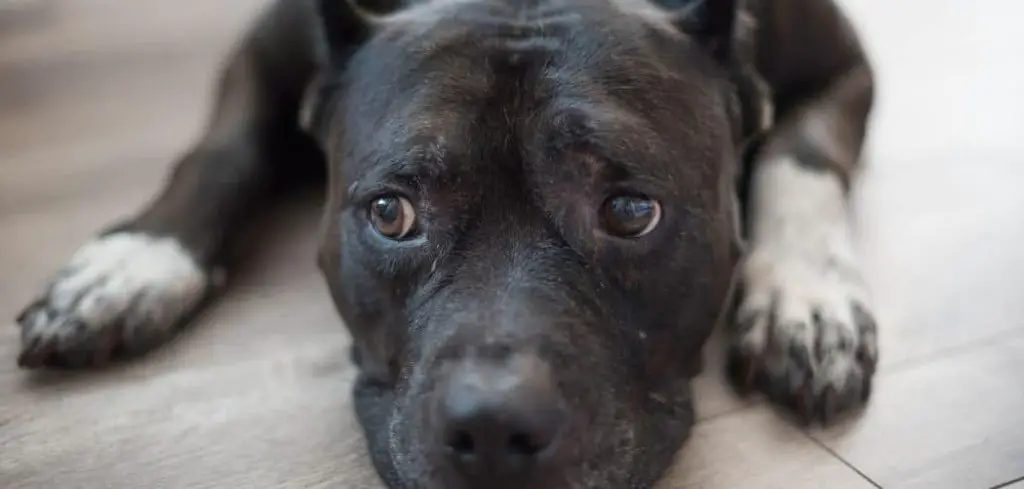A dog that is panting and appears bloated should never be ignored. These symptoms together may indicate a life-threatening condition, such as bloat (gastric dilatation-volvulus), or could point to serious pain, internal illness, or distress.
We outline the common causes of why your dog is panting and bloated, what you can do at home, and when to seek veterinary help.
Why Is My Dog Panting and Bloated — Why It Happens
Dogs may pant and become bloated due to gastric torsion, intestinal blockages, fluid retention, pain, or internal inflammation.
While panting is the body’s way of coping with stress, overheating, or discomfort, when paired with abdominal bloating, it can signal a medical emergency requiring immediate attention.

Common Causes of Dog Panting and Bloating
Gastric Dilatation-Volvulus (GDV / Bloat)
GDV is one of the most serious emergencies a dog can face.
It occurs when the stomach fills with gas and twists, trapping air, cutting off blood flow, and leading to shock.
Early signs include a swollen, tight abdomen, frantic panting, pacing, retching without producing vomit, and collapse.
Deep-chested breeds like Great Danes, German Shepherds, and Dobermans are most at risk.
GDV progresses rapidly and is fatal without emergency surgery—don’t wait.
Intestinal Blockage
A blockage in the digestive tract can cause bloating, pain, and panting as gas and fluids build up.
Dogs may vomit, strain to defecate, become lethargic, or show signs of abdominal discomfort.
Common culprits include swallowed toys, bones, socks, or large chunks of food.
Surgery may be needed to remove the obstruction and prevent complications like perforation.
Read more: Dog Panting and Throwing Up (What it means)
Peritonitis (Abdominal Inflammation)
Infections or ruptures inside the abdomen can lead to peritonitis—a painful, inflamed condition of the abdominal lining.
Panting results from pain and systemic stress. The belly may appear distended and very painful to the touch.
This can result from internal injuries, ruptured organs, or advanced infections.
It requires urgent veterinary intervention, including hospitalization and antibiotics.
Ascites (Fluid Accumulation)
Fluid build-up in the abdomen, known as ascites, can cause the stomach to appear bloated.
It may be linked to liver disease, heart failure, cancer, or protein imbalances.
Panting may occur as pressure increases in the abdomen, affecting breathing.
Additional signs may include lethargy, reduced appetite, and pale gums.
Diagnosis involves bloodwork, ultrasound, and sometimes draining the fluid for testing.
Heat Stress Combined With Digestive Issues
A dog who is both overheated and dealing with mild digestive upset may pant and appear temporarily bloated.
Panting could stem from both heat and discomfort.
While not always serious, this combination warrants monitoring for progression into heatstroke or more serious GI issues.
Make sure your dog is kept cool, hydrated, and rested—and contact your vet if symptoms persist.
What to Do If Your Dog Is Panting and Bloated
Immediately assess your dog’s demeanor: are they pacing, trying to vomit, or showing signs of collapse?
Do not try to massage or press on the stomach—this can worsen internal damage.
Avoid offering food or water until evaluated by a vet.
Record when the symptoms began and whether they are worsening rapidly.
Contact your veterinarian or emergency clinic right away—GDV can progress in under an hour.
Transport your dog gently, keeping them calm and upright during the ride.
When to Call or Visit Your Vet
Seek emergency veterinary care if your dog:
Has a hard, distended abdomen
Is panting excessively or appears panicked
Attempts to vomit but brings nothing up
Shows signs of collapse, pale gums, or labored breathing
Has a history of swallowing foreign objects
Acting fast can mean the difference between life and death in bloating-related emergencies.
Read more: Dog Panting and Diarrhea (What it means)
Key Takeaway
Panting and bloating in dogs should never be brushed off—this combo can signal GDV or other dangerous abdominal conditions.
Stay calm, observe closely, and don’t wait to act.
When in doubt, it’s always safer to seek emergency care to protect your dog’s life and comfort.
